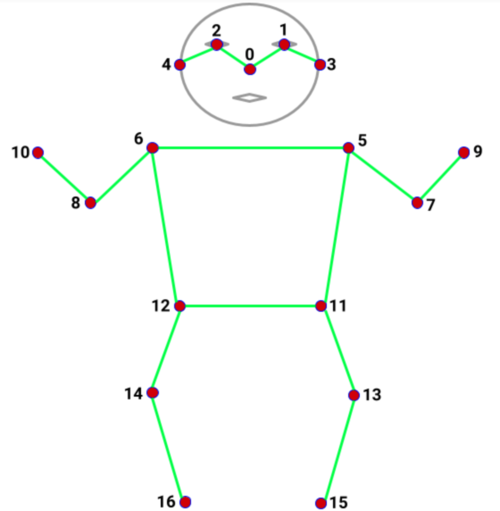This package provides multiple state-of-the-art models for running real-time pose detection.
Currently, we provide 3 model options:
MoveNet is an ultra fast and accurate model that detects 17 keypoints of a body. It can run at 50+ fps on modern laptops and phones.
MediaPipe BlazePose can detect 33 keypoints, in addition to the 17 COCO keypoints, it provides additional keypoints for face, hands and feet.
PoseNet can detect multiple poses, each pose contains 17 keypoints.
In general there are two steps:
You first create a detector by choosing one of the models from SupportedModels,
including MoveNet, BlazePose and PoseNet.
For example:
const model = poseDetection.SupportedModels.MoveNet;
const detector = await poseDetection.createDetector(model);Then you can use the detector to detect poses.
const poses = await detector.estimatePoses(image);
The returned poses list contains detected poses for each individual in the image. For single-person models, there will only be one element in the list. Currently, only PoseNet supports multi-pose estimation. If the model cannot detect any poses, the list will be empty.
For each pose, it contains a confidence score of the pose and an array of keypoints. PoseNet and MoveNet both return 17 keypoints. MediaPipe BlazePose returns 33 keypoints. Each keypoint contains x, y, score and name. In addition, MediaPipe BlazePose also returns an array of 3D keypoints.
Example output:
[
{
score: 0.8,
keypoints: [
{x: 230, y: 220, score: 0.9, score: 0.99, name: "nose"},
{x: 212, y: 190, score: 0.8, score: 0.91, name: "left_eye"},
...
],
keypoints3D: [
{x: 0.65, y: 0.11, z: 0.05, score: 0.99, name: "nose"},
...
]
}
]
For the keypoints, x and y represent the actual keypoint position in the image.
If you need normalized keypoint positions, you can use the method
poseDetection.calculator.keypointsToNormalizedKeypoints(keypoints, imageSize) to
convert x and y to [0, 1] range.
For the keypoints3D, x, y and z represent absolute distance in meters in a
2 x 2 x 2 meter cubic space. The range for each axis goes from -1 to 1 (therefore
2m total delta). The z is always perpendicular to the xy plane that passes the
center of the hip, so the coordinate for the hip center is (0, 0, 0).
The score ranges from 0 to 1. It represents the model's confidence of a keypoint. Usually, keypoints with low confidence scores should not be used. Each application may require a custom confidence threshold. For applications that require high precision, we recommend a larger confidence value. Conversely, applications that require high recall may choose to lower the threshold. The confidence values are not calibrated between models, and therefore setting a proper confidence threshold may involve some experimentation.
The name provides a label for each keypoint, such as 'nose', 'left_eye', 'right_knee', etc.
Refer to each model's documentation for specific configurations for the model and their performance.
BlazePose MediaPipe Documentation
See the diagram below for what those keypoints are and their index in the array.
0: nose
1: left_eye
2: right_eye
3: left_ear
4: right_ear
5: left_shoulder
6: right_shoulder
7: left_elbow
8: right_elbow
9: left_wrist
10: right_wrist
11: left_hip
12: right_hip
13: left_knee
14: right_knee
15: left_ankle
16: right_ankle
0: nose
1: left_eye_inner
2: left
3: left_eye_outer
4: right_eye_inner
5: right_eye
6: right_eye_outer
7: left_ear
8: right_ear
9: mouth_left
10: mouth_right
11: left_shoulder
12: right_shoulder
13: left_elbow
14: right_elbow
15: left_wrist
16: right_wrist
17: left_pinky
18: right_pinky
19: left_index
20: right_index
21: left_thumb
22: right_thumb
23: left_hip
24: right_hip
25: left_knee
26: right_knee
27: left_ankle
28: right_ankle
29: left_heel
30: right_heel
31: left_foot_index
32: right_foot_index
You may reference the demos for code examples. Details for how to run the demos
are included in the demos/
folder.

